Challenges of Pest Controls
Accurately timing a control tactic against the most vulnerable stage of an insect’s development allows for the use of biorational pesticides as well as less use of traditional pesticides. Unfortunately, accurately timing controls is difficult because of the complex array of landscape plants and pests that can be present on any one site. IPM methods require knowledge of the pest’s life cycle stages and when the vulnerable stage occurs for each pest. It requires knowledge of what pesticides will suppress the pest as well as their relative toxicities. This extensive amount of information can become overwhelming, especially to the less experienced landscaper or arborist.
Some landscape managers often resign to the easy, yet environmentally unsound practice of using four or more preventative cover sprays of pesticides each year. Studies have shown that typically only 2% of a blanket spray actually hits a targeted pest, with the remaining 98% contaminating the surrounding environment. Is there another way that pesticides can be applied more intelligently?

Farmers know that when White Oak leaves are the size of a squirrel’s ear, THEN…. (Photo Credit: Steven K. Rettke, Rutgers Coop. Ext.)
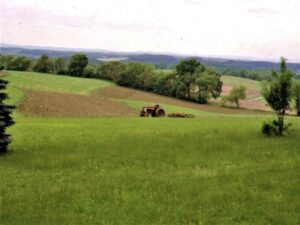
….THEN, =It is time to Sow Corn into the planting fields. (Photo Credit: Steven K. Rettke, Rutgers Coop. Ext.)
GDD vs. PPI
The concept of Growing Degree Days (GDD), or the daily accumulation of heat units to predict pest activity is used frequently within the Rutgers P&PA blogs. It can be a valuable tool to determine when a pest is active as well as its most vulnerable stage of development. However, most landscapers do not calculate the GDD units themselves (requires a Min-Max thermometer or a relatively expensive biophenometer) and many may not use the daily/weekly GDD information provided on internet websites. Therefore, without the access and constant updating of GDD information, the landscaper will find this important tool to be of little practical value.
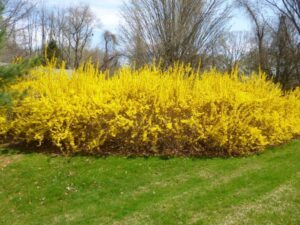
Turf managers know that when Forsythia blooms begin to fade, THEN…. (Photo Credit: Steven K. Rettke, Rutgers Coop. Ext.)
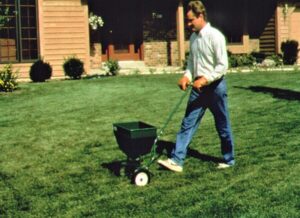
….THEN, =It is time for Crabgrass pre-emergent controls to be in place. (Photo Credit: James Willmott, former Rutgers Ag. Agent)
Another method is the possibility of timing pest activity via ornamental plant development. Using Plant Phenological Indicators (PPI) involves observing certain plants whose bloom time (flowers, leaves, fruit, etc.) coincides with a life stage event of a specific pest. As temperatures rise in the spring, both plants and insects/mites begin development and continue throughout the growing season in response to this accumulation of heat units or Growing Degree Days (GDD’s). Therefore, the development of plants can be correlated to insect activity. A PPI that nearly all turf managers are familiar with states: “To control crabgrass, apply a pre-emergent herbicide when the forsythia blooms.” (Actually, it is unfortunate that this PPI choice is not always reliable).
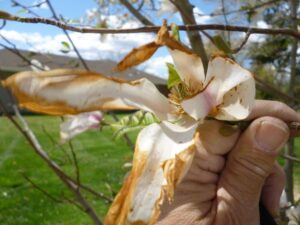
When the flower petals of the Saucer Magnolia begin to fade & drop, THEN…. (Photo Credit: Steven K. Rettke, Rutgers Coop. Ext.)

….THEN, =Young larvae of European Pine Sawflies are actively feeding. (Photo Credit: Steven K. Rettke, Rutgers Coop. Ext.)
Timing Bronze Birch Borer Emergence Using PPI
Landscapers know that white-barked birches (especially European and Asian species) are sensitive to environmental stresses that make them susceptible to bronze birch borer infestations. For most practical situations, these trees should probably be allowed to die and then replaced with a more appropriate species. In some special situations, a client may have a valuable non-native white birch in a key location that may warrant protective sprays. If general cover sprays are applied based on the calendar (i.e., early June), the birch may still succumb to the bronze birch borer (BBB) because of inaccurate spray timing. Since insect pheromones are not available to time adult emergence, PPI can be especially valuable. Since the most vulnerable stage of this pest is the newly hatched larvae, it is necessary to apply an appropriate pesticide (e.g., pyrethroids) to the bark just prior to egg laying. Based upon many years of field observations, it has been determined that the first pesticide application should be sprayed when Spirea X vanhouttei (Bridal Wreath Spirea) finishes bloom. A few other alternative plant indicators for the first spray include:
- Viburnum dentatum (Arrowwood Viburnum) at beginning bloom stage-
- Weigela florida (Old-fashioned Weigela) at the blooming stage-
- Aesculus hippocastanum (Horse Chestnut) at the late bloom stage with some blossoms brown-
With the use of systemic neonicotinoid insecticides, the treatment timing has become less critical. However, there can still be times when it is valuable to know when the BBB is actively laying eggs by observing when certain plant species are in bloom.
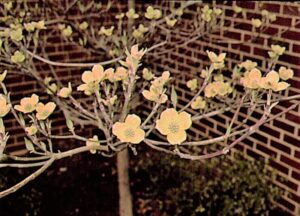
When the early bracts of the Flowering Dogwood bloom, THEN…. (Photo Credit, Steven K. Rettke, Rutgers Coop. Ext.)
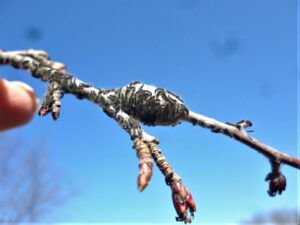
….THEN, =The early hatching of the Eastern Tent Caterpillars is occurring. (Photo Credit: Steven K. Rettke, Rutgers Coop. Ext.)
Advantages & Best Use of PPI
Along with GDD information, the use of PPI replaces the general calendar recommendations for the timing of specific pest activity that are only based on averages. General calendar spray recommendations do not compensate for localized microclimates that can experience considerable variation from a regional average. These averages can often be too early or too late by two weeks or more, depending upon if the year is cooler or warmer than usual. Additional specific, localized conditions that generally will favor later & slower development of PPI & pests can include variations such as nearer the coast, further north, in the shade, under shady skies, on a north slope, and at higher elevations.
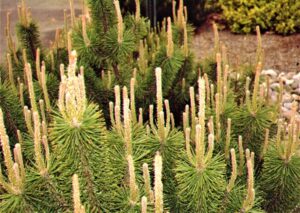
When the new growth candles of the Mugo Pine are between 1-6 inches long, but needles not extended, THEN…. (Photo Credit: Steven K. Rettke, Rutgers Coop. Ext.)
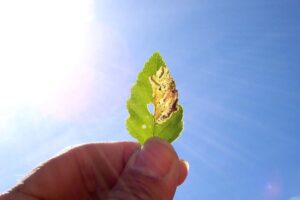
….THEN, =The young larvae of Birch Leaf Miners are actively feeding inside of leaves. (Photo Credit: Steven K. Rettke, Rutgers Coop. Ext.)
A possible advantage of using PPI over GDD is the direct observation of plant development at your landscape site. When using PPI, the observer is not dependent upon the need to constantly update GDD information. Plant indicators are an obvious signal, because you see them on site when inspecting for pest problems, or they literally “hit you in the face” during your regular scheduled maintenance. In fact, PPI are often superior to GDD for pest management timing when the GDD calculations are determined from an off-site location. Therefore, PPI can act as a refinement to improve the accuracy of GDD data when traveling from one landscape site to another during the day since microclimates are considered. The primary requirement for successfully using PPI is the ability to identify common landscape plants, usually to the species level.
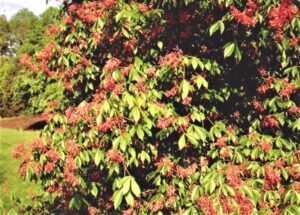
When the Horse Chestnut is in full bloom, THEN…. (Photo Credit: Steven K. Rettke, Rutgers Coop. Ext.)
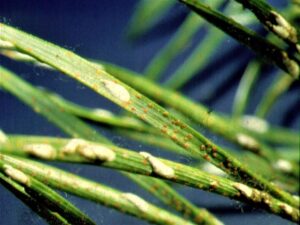
….THEN, =The crawlers of the Pine Needle Scale are exposed & are beginning to settle. (Photo Credit: Ohio State Extension)
Remember, to use PPI practically the indicator plants must be readily available to be observed. The plant should be common, have a relatively short (well-defined) bloom period that is easily recognized from a distance. Also, the plant should not be easily confused with other plants blooming. It is important to be aware that some biological uncertainty with PPI can still exist and the development of an individual plant will not always exactly coincide with temperature and pest emergence.

When Catalpa flowers begin to have their early blooms, THEN…. (Photo Credit: Steven K. Rettke, Rutgers Coop. Ext.)
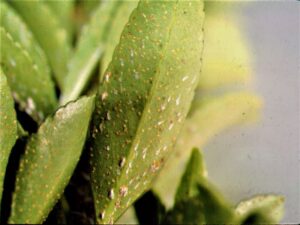
….THEN, =The crawlers of Euonymus Scales are exposed & are beginning to settle. (Photo Credit: Steven K. Rettke, Rutgers Coop. Ext.)
Conclusion:
The enclosed “Listing” at the end of this blog contains some Key Pests and a few of their corresponding Plant Phenological Indicators (PPI). (The months listed for each pest are averages for central NJ.) These plants bloom during the presence of the pest’s most vulnerable stage. Although only a few pests and their plant indicators are identified here, all the common landscape pests have identifiable PPI that can be found in the literature. Furthermore, when plant managers observe the early emergence of specific pest species at various sites, they can take note of the stages of development of plants that are nearby. These coinciding insect & plant pairs should be written down for future reference. This kind of self-determined PPI can be the most accurate since the site-specific micro-climates are considered.

When the Kousa Dogwood bracts are in full bloom, THEN…. (Photo Credit: Steven K. Rettke, Rutgers Coop. Ext.)
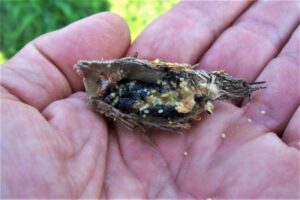
….THEN, =Bagworm hatching begins to occur & young larvae are active. (Photo Credit: Steven K. Rettke, Rutgers Coop. Ext.)
(Reference: Coincide: The Orton System of Pest Management, Donald A. Orton; 1989)
A Few Key Pests & Common Plant Phenological Indicators
SPRUCE SPIDER MITES (7-121 GDD)(April/May)
(Spring Sprays)
- –Magnolia X soulangiana (Saucer Magnolia) = PINK BUD STAGE
- –Acer saccharum (Sugar Maple) = BEGINNING BLOOM
- –Acer saccharinum (Silver Maple) = LEAF BLADES ARE 1-2” LONG
(Fall Sprays)
- -Acer saccharum (Sugar Maple) = FOLIAGE BEGINNING TO COLOR
- –Crataegus phaenopyrum (Washington hawthorn) = FRUIT BEGINNING TO RIPEN
EUROPEAN PINE SAWFLY (35-145 GDD)(April/early May)
- –Magnolia X soulangiana (Saucer Magnolia) = DROPPING PETALS
- -Amelanchier (Serviceberry) = BLOOMING
- –Acer platanoides (Norway Maple) = LATE BLOOM; LEAFING OUT
BIRCH LEAF MINER (123-290 GDD)(May)
- Spirea X vanhouttei (Bridal Wreath Spirea) = EARLY BLOOM
- Acer saccharinum (Silver Maple) = DROPPING SEED
- Pinus mugo (Mugo Pine) = CANDLES 1-6” LONG; NEEDLES NOT EXTENDED
PINE NEEDLE SCALE (298-448 GDD)(late May/early June)
(1st generation crawlers)
- Spirea X vanhouttei (Bridal Wreath Spirea) = BLOOMING
- Aesculus hippocastanum (Horse chestnut) = BLOOMING
(2nd generation crawlers)
- Daucus carota (Queen Anne’s Lace) = BLOOMING
- Sorbus aucuparia (European Mountain-ash) = FRUIT TURNING ORANGE
TWO-SPOTTED SPIDER MITES (437-997 GDD)(June)
(Begin summer spray period)
- Hydrangea arborescens ‘Grandiflora’ (Hills of Snow Hydrangea) = EARLY BLOOM
- Daucus carota (Queen Anne’s Lace) = BLOOMING
- Yucca filamentosa (Adam’s Needle) = BLOOMING
(End summer spray period)
- Sorbus aucuparia (European Mountain-ash) = FRUIT VERY ORANGE
- Solidago (Goldenrod) = SOME BLOOMING
EUONYMUS SCALE (533-820 GDD)(June)
(1st generation crawlers)
- Syringa reticulata (Japanese Tree Lilac) = EARLY BLOOM
- Cornus kousa (Kousa Dogwood) = BLOOM
- Crategus crus-gali (Cockspur Hawthorn) = BLOOMING
BAGWORM (600-900 GDD)(June)
- Catalpa speciosa (Northern Catalpa) = FULL BLOOM
- Syringa reticulata (Japanese Tree Lilac) = FULL BLOOM
- Philadelphus (Mock-orange) = BLOOMING

